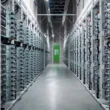Uptime Institute has projected that the data center industry will confront significant challenges in 2025, driven by escalating demands for sustainability, grid integration, and the infrastructure necessary for artificial intelligence (AI). As data centers evolve to support AI workloads, new hardware and innovative power distribution methods are crucial. The rising energy consumption from these facilities will spark public scrutiny and opposition, urging developers and operators to adopt a more transparent and cooperative approach to their operations.
The Uptime Institute’s report, "Five Data Centers Predictions for 2025," highlights several key areas of focus:
Public Scrutiny and Opposition
Data centers are expected to come under increased public scrutiny due to their substantial resource consumption and environmental impact. This scrutiny is heightened by the rapid expansion of data centers, which are projected to consume 20% to 30% of power resources in some locations. In response to these challenges, operators will need to engage more proactively with communities and address concerns surrounding sustainability and environmental regulations, which may impede new developments.
Cloud Training for AI Models
The Institute predicts that the majority of AI model training will migrate to cloud platforms. This shift is attributed to the cost-effectiveness of cloud services, which allow enterprises to fine-tune AI models without needing large, dedicated on-site infrastructure. By leveraging cloud resources, organizations can access the necessary computational power on-demand, avoiding the significant expenses associated with maintaining dedicated hardware.
Data Center Collaboration with Utilities
As new data centers emerge, collaboration with utility companies will become essential. Developers will have to work closely with power providers to ensure stability and manage demand, potentially adjusting energy loads during peak usage times. Data centers executing non-immediate tasks, like certain AI training processes, may receive financial incentives to curtail their power consumption when needed.
Radical Data Center Electrification
The anticipated rise in AI workloads mandates a shift toward medium voltage systems within data centers, demanding extreme electrification. To support the higher power densities associated with AI systems, which can reach up to 120 kW per rack, the design and layout of electrical infrastructure will need reevaluation.
Alternatives to Nvidia
Concerns over Nvidia’s dominance in the GPU market are prompting organizations to seek diverse options for AI processing. As diverse AI hardware continues to emerge, alternatives to Nvidia’s high-density, energy-intensive systems are expected to flourish. Companies may choose to utilize general-purpose pre-trained models, leveraging cloud services for fine-tuning rather than investing heavily in specialized AI infrastructures.
In summary, the future of data centers is poised for transformation, shaped by sustainability concerns, technological demands, and shifts in resource utilization strategies. As the industry adapts, the balance between operational needs and environmental responsibilities will become increasingly pivotal.
For further details, refer to the original predictions by the Uptime Institute in their report: Five Data Centers Predictions for 2025.











